
20 Years of Military Flight Simulations, 1980-2000
The Mature Years: 1997-2000
Combatsim.com founded
In February of 1997 the first commercial Internet magazine dedicated to combat simulations was founded. www.combatsim.com was registered as a domain name in February by Doug Helmer and Len "Viking 1" Hjalmarson. These two Canadian simulation fans gave a voice to the growing virtual community that was taking shape around combat simulations on the PC.
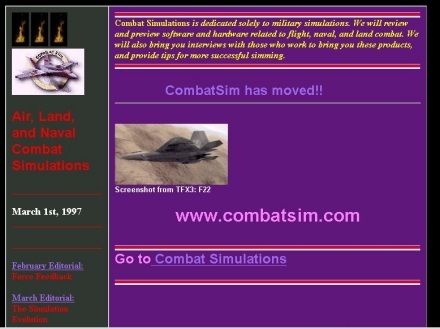
Internet Explorer showing the beginnings in 1997.
In 1997 Digital Integration released F-16 Fighting Falcon with their unique "headlock" target tracking system. Not long afterward a patch was released that included 3dfx support.
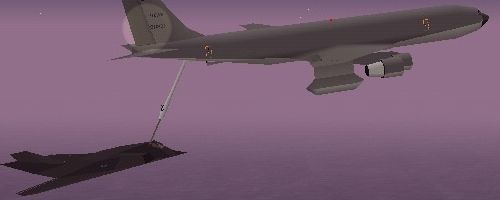
F-22 ADF
In 1997 Digital Image Design released F-22 ADF, a title which had evolved from EF 2000 and was originally intended to be Total Air War. The game was innovative enough that DiD scooped TWO Top Games Industry ‘Oscars’ at Milia d’Or Awards Ceremony in Cannes, France in February. This was the first time that Milia d’Or awarded first prize to a military simulation.
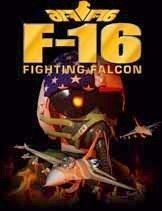
F16 Fighting Falcon
3D graphics wars heat up
Graphic Simulations released a new iteration of F/A-18 3.0 titled F/A-18 Korea, complete with 3DFX Voodoosupport. This detailed simulation of the F/A 18 had the most beautiful skies and clouds yet seen on the PC.
In this same year Looking Glass Technologies released Flight Unlimited III, and Microsoft released Microsoft Flight Sim 98.
Imagic released iF-22, Eidos released Joint Strike Fighter and EA released US Navy Fighters '97.
Joint Strike Fighter was developed by Innerloop in Norway. The graphics were stunning, but required high end hardware to notch them up (Pentium 233MMX with 64MB and 3DFX Voodoo.
The 3d accelerator wars were heating up at this time, with Nvidia, S3, ATI, Matrox, and 3DFX Voodoov ying for top honors.
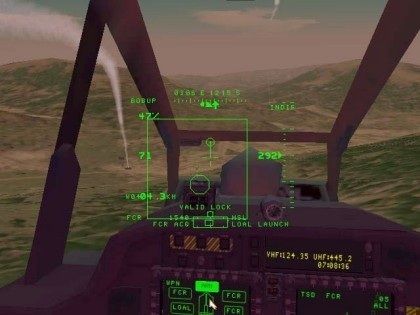
Graphics and Weapon Systems in LB2 were realistic.
Jane’s Combat Simulations released Longbow 2 in mid year, a game many consider the best helicopter simulation ever. With a fully dynamic campaign system, and the first use of dynamic lighting seen in a PC simulation, the game was both beautiful and challenging. Mission variety was huge, and a powerful mission planner made it even better. Jane’s innovations included voice narrative in-flight training, first seen in the original Jane’s Longbow.
Longbow 2 modeled three flyable helicopters: the AH-64D Longbow, the Kiowa Warrior and the Black Hawk troop transport. Multiplayer support was good, and many dedicated Longbow squadrons sprang up on the Internet.
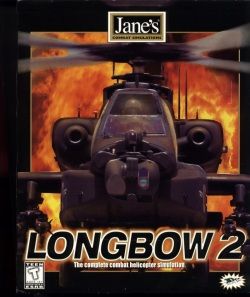
Longbow 2 Box.
Voice Control!
Around this same time a voice over net utility called Roger Wilco was released. This utility ran in the background and allowed players to communicate to one another via voice using the same data channel as the simulation connection. In the early days this required two sound cards, but eventually the software and hardware matured to allow methods of separating sound channels and resources apart from what the game itself was using. Roughly a year later another product like RW appeared, called Battlefield Communicator.
Sometime in the early summer Titanic was released, a huge production destined for many Oscars. Evita was also a big hit in this year.
In 1997 Rowan’s Flying Corps took to the air, and set a new standard for WWI simulations. This one sported three scripted campaigns, and a fourth that was dynamic. Graphics were soon updated with 3dfx support, and flight models were of a high standard. With Flying Corps Rowan pioneered an auto switching padlock system that took the player from internal perspective to an outside player-to-target view when the bandit passed outside the front view area.
Flying Corps also saw larger furballs than we had ever seen before, and was one of the earliest simulations to support force feedback. For the first time in a PC simulation, players could not only see and hear their guns firing, but feel the recoil. When the aircraft began to stall, the buffet effects were transferred via the stick to our wrists. It was an amazing advance.
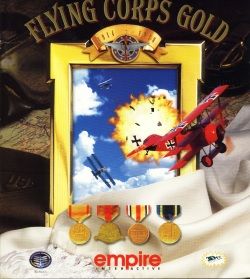
Flying Corps Gold box
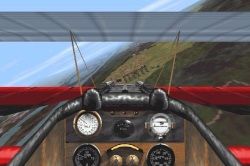
Fokker Triplane in Flying Corps
The first company to release a force feedback joystick was CH Products. Their Force FX was expensive, large, and used the serial port to communicate with the PC. While the stick worked great once configured, it was often difficult to get the PC to recognize the gear. COMM ports and their Interrupts, the old bane of the PC, caused many problems with serial port hardware. It would be almost two years before the first USB based force feedback hardware arrived on the scene.
SimHQ.com is founded
SimHQ.com was founded in 1997. This fan site has grown to enjoy the support of thousands of simulation enthusiasts and sports some of the most active simulation forums on the Internet.
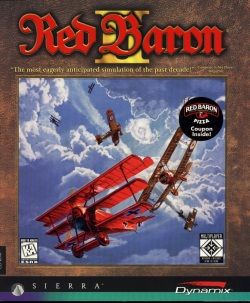
Red Baron II box.
Later in 1997 Dynamix released Red Baron II. A new landmark for WWI simulations, RBII sported a fully dynamic campaign system and modeled more than a dozen flyable aircraft. Many players complained about the graphics, which were later updated with 3dfx support in a free patch. The flight model was also adjusted post-release, since somewhere before the release date it was rendered less daunting. - Red Baron 3D.
The multiplayer features of Red Baron II were also very strong, and the ability to paint your own aircraft and transfer the skin to other players so they would see a unique aircraft while flying online lent personality to the game. RB II is still a favorite for online play.
John Denver died in the fall of this year when the light aircraft he was flying had a mechanical failure.
Also late in 1997 the second edition of 3DFX Voodoo Voodoo chipset arrived in such hardware as Canopus Pure3d II, and Orchid’s Righteous 3d II. This second generation chip sported 2.5x the power of the first generation, and game producers were quick to take advantage of the additional processing power.
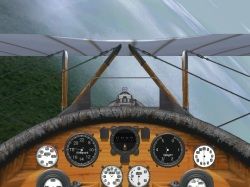
Cockpit in RB II 3D
European Air War
In 1998 Microprose released European Air War, considered by many to be the best WWII combat simulation ever. The initial release allowed only 640x480 resolution, but the game was atmospheric in the extreme. Voice and sound effects were excellent and the wingman command structure was broad and effective.
Furthermore, flight models were solid, and the dynamic campaign supported large flights of aircraft and excellent action. Multiplayer features were also quite good and many online squadrons still fly European Air War. A huge variety of end-user modifications have extended the life of this game, including sound packs, mission packs and campaigns and new aircraft.
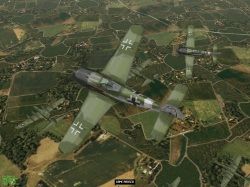
FW-190 and B17 in European Air War
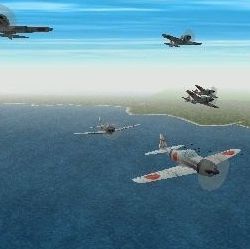
Air Warrior 3
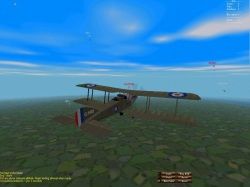
Dawn of AcesOnline
1998 might be the year that the MMOG came into their own. MMOG is an acronym that stands for mega-multiplayer online games.
In 1998 Air Warrior III appeared, an online only simulation that fought with WarBirds 2for air dominance. With dedicated online communities numbering in the thousands, the online arenas for these games can support as many as five hundred players simultaneously.
The online experience up to 1997 was a mixed bag of bad connections, poor software, and overworked hardware. But the improvement in online code, the rapidly growing horsepower of the PC, and the growing number of Internet users were conspiring to change the face of online gaming.
By 1998 MMOG games were coming into their own. Microsoft launched their Gaming Zone in 1997 and Fighter Ace was released in November. By 1998 the Zone supported a number of multiplayer arenas, including one for Red Baron II and European Air War.
In 1998 iMagic Online’s Dawn of Acestook the player back to the world of biplanes and Lewis guns, and Novalogiccontinued to grow their own MMOG venue with F22 Lightning II Novaworld.
DEBRIEF magazine
In the summer of 1998 the first issue of DEBRIEF appeared, a print magazine published by Tom Basham and dedicated to simulations and strategy games. DEBRIEF attempted to appeal to a niche market as well as to integrate the real world of the military with the simulated world of combat on the PC. Unfortunately, DEBRIEF only survived a year of publication.
During the summer Logitech’s second entry into the force feedback market appeared with their Wingman Force joystick. This stick was an all-in-one solution, featuring both serial and USB connectivity, a twist handle for rudder, and a throttle wheel. The Wingman was in direct competition with Microsoft’s Sidewinder Force, released the previous year.
Not long after the release of this stick a driver update allowed me to run my gameport rudder pedals at the same time as I used the Wingman. This greatly added to control precision in WWII sims, and the Logitech Wingman became my stick of choice for prop simulations.
Some gamers were too busy in the theatres watching Saving Private Ryan to spend much time flying this summer. This war movie with Tom Hanks set a new standard for realism in WWII combat flicks.
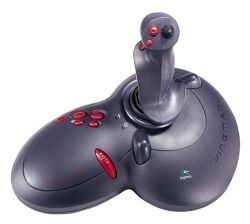
Logitech Wingman Force
F-15 by Janes
Jane’s released F-15 by Janes Combat Simulationsin the summer of 1998 and set a new milestone for jet combat simulations. F-15 by Janes Combat Simulationssported the most detailed wingman and AWACS interaction yet seen. Flight models were outstanding, with the most detailed physics yet seen in flight. Team tactics took on new meaning, and the semi-dynamic campaign system created a highly immersive combat environment.
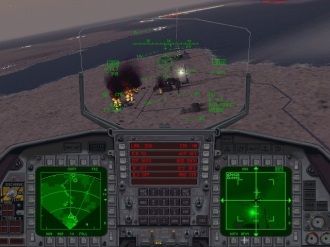
F15 Cockpit in F-15 by Janes Combat Simulations.
The graphics of F15 were best on 3DFX Voodoo, but acceptable without it.
Sometime in the spring of this year Mindmaker, Inc. released their Game Commander software, giving any PC gamer the opportunity of incorporating voice control in his favorite simulations! My first trials were with European Air War, and then F-15 by Janes Combat Simulations. I was stunned at the ability to simply say "drag left", or "drop tanks" and have my flight obey me!
EA released Israeli Air Forceby Pixel Multimedia in 1998, finally retiring the US Navy Fightersengine. While Israeli Air Forcehad great multiplayer features and modeled a number of flyable aircraft, the graphics engine produced an odd shimmering effect that bothered some players.
GT Interactive published SIMIS Team Apache (1998) by Simis, Digital Image Designreleased Total Air War and iMagic released their iF/A-18E Carrier Strike Fighter. iF/A-18E Carrier Strike Fighter was acclaimed for its campaign system and flight modeling, but plagued with installation and graphics issues.
World War Fighters by Janes
In the spring Creative Labs released their latest sound hardware in the form of the SB Live. This was by far the best gaming sound board released to that time, and with its "environmental extensions", or EAX technology, raised the benchmark for sound standards in PC games.
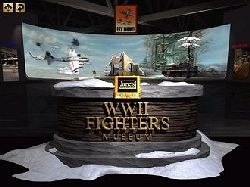
World War 2 Fighters Museum Interface
Jane’s Combat Simulations released World War 2 Fightersin the summer, with advanced graphics and incredible cockpits. The interface was unique, the metaphor a WWII military museum. The aircraft themselves were the most detailed seen to this date, and the game had excellent sound and fantastic clouds. World War 2 Fightersmay have epitomized the 3DFX Voodoographics Glide API.
World War 2 Fighters also had excellent multiplayer support, and spawned another dedicated online community. While some players complained that the flight models were not detailed enough, there was plenty of challenge for the average player, and the included mission builder extended the life and interest of the simulation. World War 2 Fighterswas a stretch for hardware at the time, but aged very well and continues to sell well.
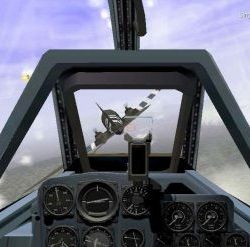
Me109 closing on bandit in Jane’s World War 2 Fighters
Total Air War
Total Air Warwas another unique release in 1998, and like F-22 ADFwas destined to win design awards. Total Air Warmodeled a huge dynamic campaign environment. It allowed the player to fly in the war, or to direct the action from a gods-eye AWACS view.
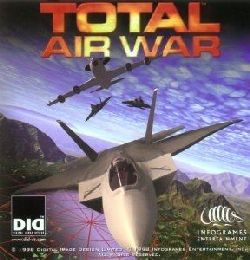
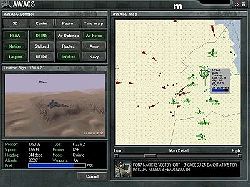
Total Air WarAWACS module.
The war in Total Air Warcontinued in real time whether the player flew or not. Uniquely, the AWACS module in Total Air Warprovided a real time window to the action while the player could watch and direct intercepts from the AWACS map. Additionally, the War Room interface allowed the player to assess the strategic battle and adjust his strategy in order to win the war. Those who preferred simply to fly and fight could play it that way.
Total Air Warwas great fun and sported a huge vocabulary, with a solid wingman command structure and ability to interact with AWACS, JSTARS and ATC. Total Air Warlooked great under 3DFX Voodoo, rivaling Jane’s World War 2 Fightersfor raw beauty. It also rivals World War 2 Fightersfor longevity, being one of the oldest sims still resident on my hard drive.
Microsoft's first Combat flight sim
In the fall Microsoft released their first Microsoft Combat Flight Simulator (1998), based firmly on the Microsoft Flight Sim 98engine. This release drove seasoned simulation fans crazy by slavishly following the unfamiliar conventions of the civilian series, including a unique and unfamiliar command style.
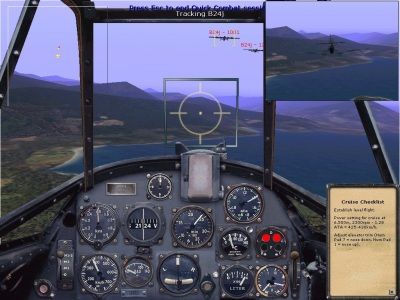
Bf-109 in Microsoft Combat Flight Simulator (1998).
While Microsoft Combat Flight Simulator (1998)had much to commend it, including good flight models and great looking terrain, it completely lacked wingman commands and a real campaign mode. At the same time, Microsoft Combat Flight Simulator (1998)was innovative with its pilot AI, creating situational awareness zones and simulating the AI pilot’s actual input to the control stick.
Microsoft Combat Flight Simulator (1998)appealed to a broad market and due largely to the Microsoft name has outsold any military flight simulation to date.
The pace picks up...
The pace in 1998 was grueling, the advances... legion.
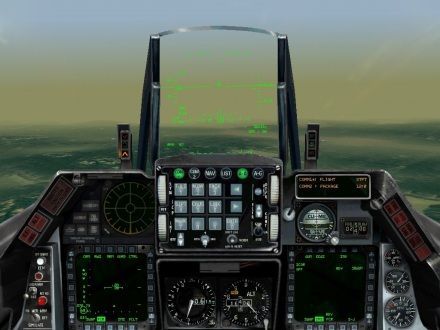
F16 Cockpit in Falcon 4.0
Improvements in hardware were enabling programmers to realize many of their dreams, and 3d accelerators were still new to the mix. Rendition and Nvidia were contending hotly with 3dfx for the 3d accelerator crown.
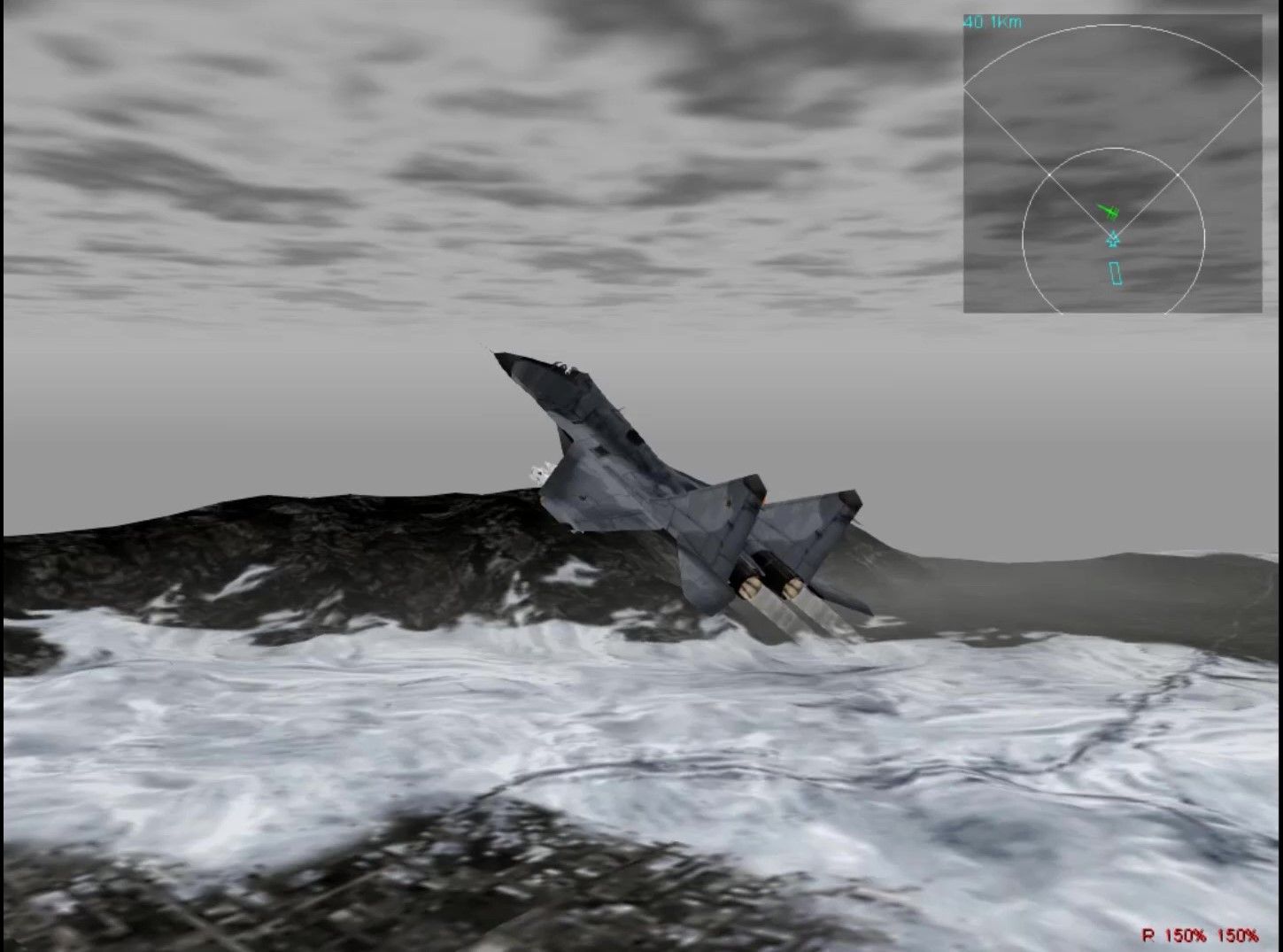
In the fall Novalogic released F-16 Multi Role Fighter and MiG-29 Fulcrum - (Novalogic - 1998), boxed simulations that were aimed at online play.
At the close of the year, in a kind of macabre capstone to the proceedings, Microprose released the long awaited Falcon 4.0.
Falcon 4.0 had been at least four years in development. The project had almost ended in the garbage bin two or three times. In the end Gilman Louie salvaged it, and with the help of Leon Rosenshein as Lead Engineer, Kevin Klemmick writing the campaign AI, and Pete Bonanni (a serving USAF Viper pilot) pulled off a sweeping simulation of the F16 and its combat environment.
Falcon 4.0
Falcon 4.0 was incredible. It was initially released with a huge ring binder in the military manual style, with removable pages since it was expected that new pages would be added as the simulation grew.
At the time I mimicked Charles Dickens introduction to Tale of Two Cities and wrote of it, "It was the best of sims, it was the worst of sims."
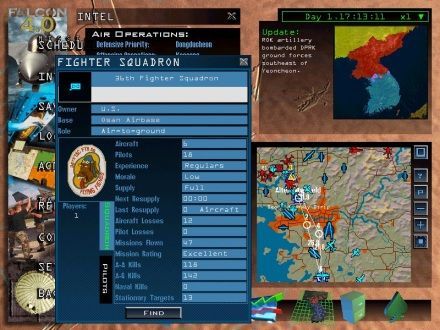
Real-time Campaign in Falcon 4.0
Anyone could see that the depth and breadth of the game was fantastic, but it was plagued by bugs, and much of the campaign was broken. The first patch finally arrived six months later, and the second a full year later in December of 1999. By version 1.08 Falcon was beginning to live up to expectations.
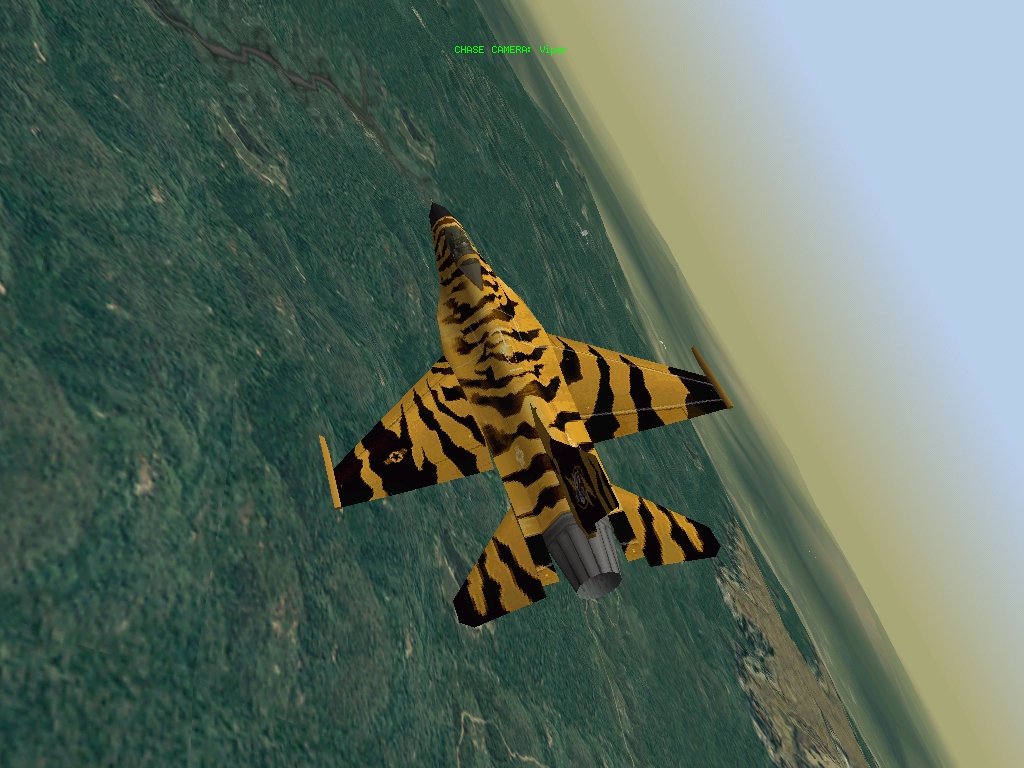
Falcon 4.0
In spite of the problems, Falcon 4.0 modelled a real time and fully dynamic air and ground war, with full ATC, a detailed and complex system of communications interaction with AWACS, JSTARS, FAC and wingmen, and even allowed dynamic entry and exit into the multiplayer game. The padlock system was the most flexible yet seen.
Falcon 4.0 began to really hit its stride in the spring of 1999 as the iBeta team http://www.ibeta.com continued to fix bugs, improve multiplayer features, and release unofficial patches.
The Mature Years: 1997-2000
In 1999 Novalogic's third iteration of F22 Lightning - F-22 Lightning 3- arrived, updated with support for massive multiplayer on Novaworld.
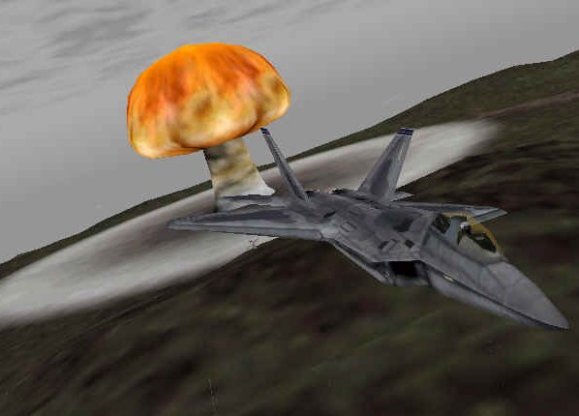
F-22 Lightning 3
Digital Integration released their long awaited F/A-18E Super Hornet late in the year, heralded as sporting the most realistic avionics ever. While the campaign and wingman interaction was weak, the aircraft and systems were modelled well.
MiG Alley
Rowan outdid themselves in 1999 with the acclaimed MiG Alley, the first detailed simulation of the Korean conflict, when jets fought with propeller driven aircraft. Modelling five flyable aircraft including the F86 Sabre, the MiG 15bis, the F84 Thunderjet, the F80 Shooting Star, and the F51 Mustang, MiG Alley allowed detailed mission planning and significant strategic interaction within the campaign.
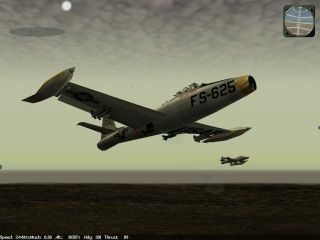
F-84 in MiG Alley
MiG Alley also included a solid wingman command structure and interaction with Forward Air Controllers. It had a great variety of missions and sported outstanding flight models. MiG Alley is still renowned for some of the best dogfighting action yet seen and remains a benchmark combat flight simulation.
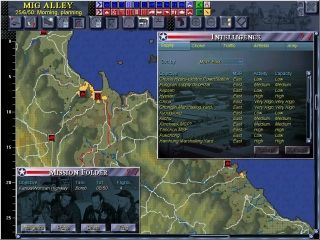
USAF
For others the highlight of the year was the arrival of Strategic Simulations Inc's Su-27 Flanker 2.0.
Austere in atmosphere but outstanding in detail, Su-27 Flanker 2.0 continued to be improved and expanded with a series of feature patches.
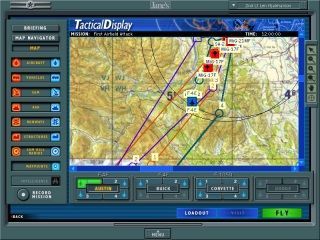
Tactical view in USAF
Still others would name Jane's USAF as the best looking and most fun military simulation ever. Modeling eight American military jets and spanning action from Korea to the present day, USAF remains popular and continues to do well at retail.
USAF took maximum advantage of the latest crop of 3d accelerators, and looked simply splendid on high end PCs (PII or PIII 500 or better with 128MB).
The most recent simulation of such unusual aircraft as the F117 Stealth Fighter, USAF rode the thin line between realism and gameplay and probably attracted many novices to the hobby.
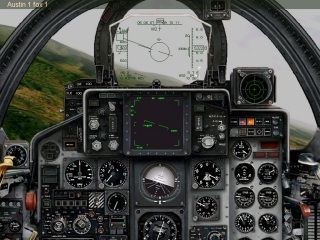
F4 Cockpit in USAF
Enemy Engaged
Razorworks Enemy Engaged: Apache vs. Havoc also arrived in 1999, heralding a series that would reach a climax with Enemy Engaged: Comanche vs Hokum in 2000.
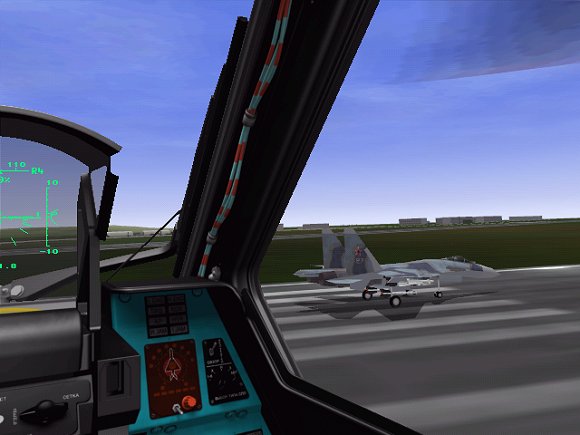
Enemy Engaged
Plagued by AI weaknesses but rich in action and terrain detail, the game featured a semi-dynamic campaign environment.
For civilian simulation fans, 1999 was the year that Terminal Reality released FLY!.
This civil aviation simulation was plagued by bugs but gradually became an outstanding package, incorporating many features that came to Microsoft Flight Simulator 2000 only via add-ons.
Meanwhile Microsoft released the second iteration of Fighter Ace, their online simulation based on the Gaming Zone.
Fighter Ace 2 has great graphics and effects and levels of challenge vary in different arenas.
1999 saw the death of Dynamix and the cancellation of Desert Fighters.
Late in the year Psygnosis released Nations: Fighter Command, a WWII simulation that was plagued with problems and rushed out the door.
Jane’s cancelled their A-10 Warthog in the middle of the year, a much anticipated product whose cancellation raised the ire of combat simulation fans worldwide.
Su-27 Flanker 2.0
In 1999 Strategic Simulations Inc released their long awaited sequel to Su-27 Flanker, Su-27 Flanker 2.0. This high fidelity simulation of the navalized Russian Flanker finally brought the popular product into the modern graphical world, even adding clouds and weather.
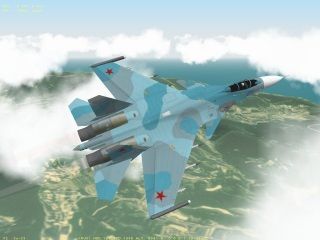
Su-27 Flanker 2.0
Su-27 Flanker 2.0 has some of the best looking aircraft models currently on the PC. The game is also popular with online pilots, and sports excellent weapons modeling. While also strong in flight model and avionics, the sim lacked something in gameplay. SSI promised to bring improvements, and has released a number of patches toward that end.
3DFX and Nvidia battle it out
1999 also saw the release of Nvidia’s Geforce chip and 3DFX Voodoo V5000 series.
Up to this time 3DFX Voodoo held the lead in 3d acceleration, but Nvidia was hard on their heels. The release of the Nvidia TNT2 chip in 1998 gave them a large market share, but they competed with 3dfx Banshee chip, with both of these a single board solution for 2d and 3d acceleration.
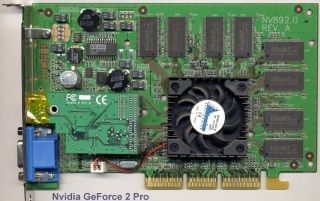
Nvidia GF2 Pro
The release of the Geforce chip, billed as a GPU (graphics processing unit) seemed to place the game on another footing. Combined with an excessively long development cycle and other unknown business issues, 3dfx was on the decline.
Meanwhile 3d acceleration was coming into its own and the graphical appeal and detailing of combat flight simulations was rapidly increasing. Virtual pilots now had two key decisions to make as they considered upgrading their hardware: which CPU to purchase, and which video board.
Nvidia’s GeForce GPU chose a new track, one initiated years before by Rendition, by offloading the CPU from the tasks of transformation and lighting. T&L had been a CPU intensive task, and offloading texture processing and lighting to the video board was a way around the bottleneck of the PCI bus as well as a means to free processor cycles for other work.
AMD, a new chip off the old block
The upgrade decision became even more complicated as AMD released better CPUs. Their K6 had become popular as budget solutions and alternatives to the ubiquitous Intel brand, but it was tough to compete with Intel’s budget Celeron solution in 1998.
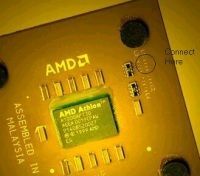
AMD Athlon
This CPU had the Pentium II core with only half the cache. But that cache ran at full processor speed, and that made it a gaming powerhouse, at less than half the price of the same clock speed Pentium II chip. Moreover, the Celeron “A” overclocked beautifully, with most of us running 300MHz CPUs at 450MHz.
This made things tough on AMD, but they were down and not out. When they released the K7 (Athlon) in 1999, the gaming market changed forever.
The Athlon was and is a splendid feat of engineering. Completely x86 compatible and a sixth generation CPU, it outpaced the Pentium III at the same clock speeds. Introduced at the 450MHz mark, AMD quickly ramped up production until they were competing neck in neck with Pentium III clock speeds. The Athlon, however, was cheaper than Intel’s flagship CPU and AMD quickly stole market share from Intel.
Nations
Late in 1999 Digital Integration's F/A-18E Super Hornet arrived on the scene. A beautiful simulation, it featured avionics detailing even beyond Graphic Simulations Corporation's F/A-18 Korea, , and sported a fully populated carrier deck. Carrier ops had arrived in style, and the only thing the game really lacked was the promised dynamic campaign.
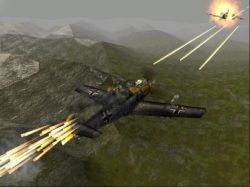
Gunfight in Nations: WWII Fighter Command
Finally, in late November Psygnosis released Nations: WWII Fighter Command. This title had shown great promise, breaking ground in particular with some of the most atmospheric graphics seen to that time. Unfortunately, the production team was troubled by the loss of key personnel and Nations was rushed out the door unfinished.
F/A-18 by Janes
2000 was led off by the swan song of Jane’s Combat Simulations in F/A-18 by Janes, a benchmark by any standard. Beautiful skies and detailed COMMS contribute to involvement. Carrier ops, avionics and weapons are simulated in exacting detail and the manual is excellent.
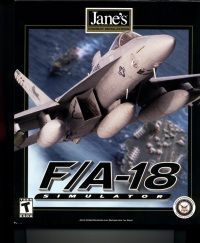
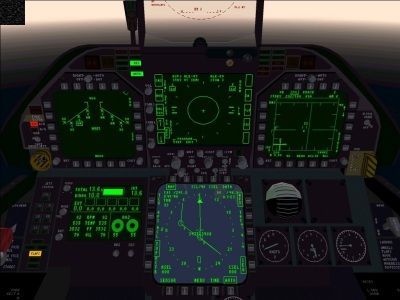
The cockpit in F/A-18 by Janes
A powerful mission builder and campaign builder were included, and the semi-dynamic campaign was a strong feature. (A new campaign was released in November of 2000 by James Campisi and Matt Wagner).
Helicopters
Razorworks in the UK met the challenge with Enemy Engaged: Comanche vs Hokum. Building on Enemy Engaged: Apache vs. Havoc, the fully dynamic campaign is matched by outstanding graphical detail and fantastic gameplay. The flight models are strong, and a huge variety of weapons and combat platforms appear in the game.
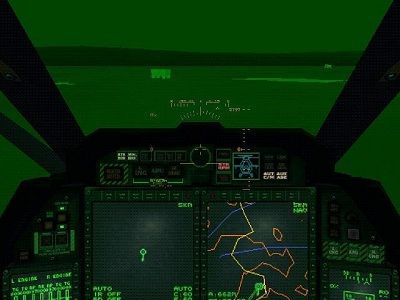
Furthermore, multiplayer features in Enemy Engaged: Comanche vs Hokum are strong, and it was this combat helicopter sim that finally caused many players to remove Longbow 2 from their hard drives.
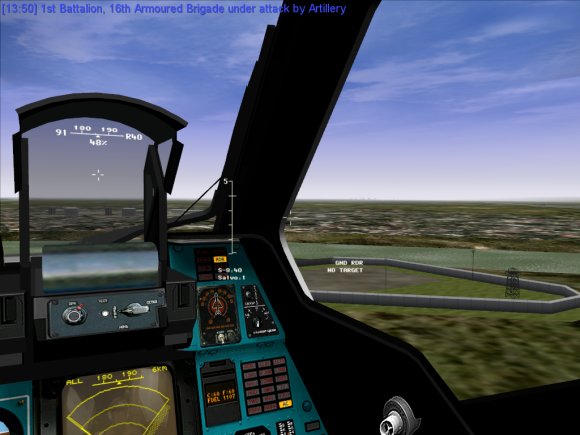
This year also saw the release of Simis Ka-52 Team Alligator. Building on Team Apache (1998) by Simis, Ka-52 Team Alligator has greatly improved AI and graphics. As with the earlier release, there is a unique emphasis on team management and morale. The campaign system in Ka-52 Team Alligator was semi-dynamic.
Microsoft Combat Flight Sim 2
It wasn’t a banner year for boxed simulations, but the movies were hot. Gladiator, the Patriot, and U-571 all came to the screen this year. While not historically accurate, U-571 is one of the all time best submariner action flicks.
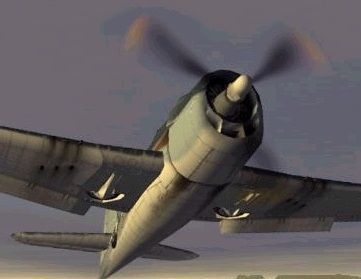
While boxed retail releases have been fewer, online games appear to have increased. HiTech Creations released Aces High in January of 2000, and has been constantly upgrading and expanding the world, eventually including naval units. Claimed to sport some of the best online flight models ever, and with a host of flyable aircraft, Aces High is an impressive online simulation.
In August of 2000 I heard from Mike Gilmartin that Confirmed Kill (CK) was still alive and kicking. This WWII prop sim was designed to compete with WarBirds and Air Warrior, and had been in development on and off since around 1997. Mike and some others purchased the rights to CK from Eidos and formed a new company, but nothing more has been heard on CK since August of 2000.
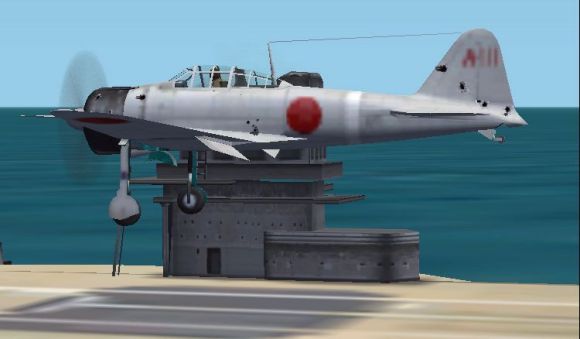
In October Microsoft released their Microsoft Combat Flight Sim 2 : Pacific Theatre. Though reviews were mixed, the game is atmospheric, with solid flight models and the most beautiful aircraft ever.
Microsoft Combat Flight Sim 2 added wingman commands to the game, as well as carrier ops. The command structure remained unchanged, but added the option of a command key set more similar to that used by generic combat flight sims.
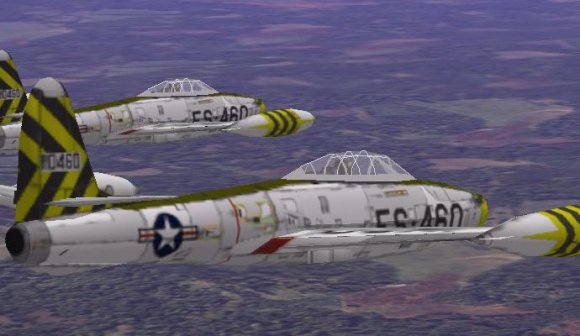
Thunderjets Over Korea
The user community behind the original Microsoft Combat Flight Simulator (1998) adopted Microsoft Combat Flight Sim 2 quickly, and even before the release new user created aircraft were appearing. Some of these, like those by Roger Dial and Eric Joiner, rival the beauty of the aircraft in the original release. Thunderjets Over Korea is destined to spawn many add-ons.
Jetfighter 4
In November Mission Studios released the fourth installment of their Jetfighter series - JetFighter 4. This is an action style simulation with the campaign set in the USA. The pilot defends America against invasion. Terrain detail is particularly high, with downtown San Francisco and a 50,000 square mile surrounding area recreated with textured photography. JetFighter 4 allows the piloting of the F-14 TomCat, the F-22 Raptor, and the F/A-18 Hornet. Multiplayer support includes LAN or internet with up to 16 players.
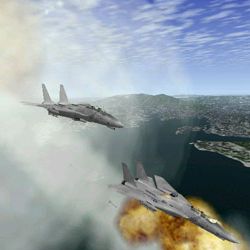
Jetfighter 4
